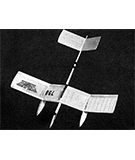 Random image Random image |
 |

WATER BUG
Comments: 0
nitrocharged
|
 |
|
 |
 |
JETWING
| JETWING |
| Description: |
Reprinted from Model Planes Annual, November 1948, pp. 44ff.
BUILD THIS 19" SPAN FLYING WING FOR THE JETEX 100
THE smallest Jetex propulsion unit—the 100—is ideal for all sheet models of the chuck glider variety. We have based the Jetwing design on experience gained with sheet flying wing gliders. All up weight of the model presented here is slightly less than 2 ounces.
An average speed builder should not take more than three or four hours to get this model ready for its first test flight. Construction is simple—providing you follow the correct building sequence. All parts are given full size [in the original published plan], so trace or pin prick them on to the appropriate thickness sheet. The one-third scale drawing on the opposite page [in the original published article, but here inserted into the plan] gives assembly details.
Begin by cutting out all the parts. Two laminations of 3/16"-in. sheet—instead of the 3/8"-in. sheet—may be substituted for the fuselage (1). Two pieces (5 and 6) will have to be joined for the main wing panels because of the width.
WING
Pin 5 flat on the plan, then cement (and pin down) 6 and 7 to it. When dry, remove from the plan and shape to the indicated sections. Use a sharp razor blade to trim away most of the surplus wood, then finish off with fine sandpaper. Note than the wings do not taper in thickness towards the tips. Build the opposite wing panel in the same way. Now place the central edges of the wing panels on the edge of the building board and sand them to a slight angle for the dihedral. Pin one panel to the building board and prop up the other 3 1/4-in. at the tip, then cement together. Now cut away the tips (7) and re-cement them in place at the angle shown. Pin each panel flat on the board in turn and use the angle template "X" to obtain the correct incidence.
FINS
The fins are toed in and are upright in the front view. The best way to ensure fitting them accurately is as follows. Invert the wing and prop it up at zero incidence by insetting a support under the centre section (about 3 1/4-in. high). Now attach the fins, checking for vertical alignment with a square placed on the building board.
The outer edges of the fins are left flat and the inner faces rounded out at the leading and trailing edges.
FUSELAGE
Cement the 1/4-in. sheet fairings (3) to either side of the fuselage (1). Cut a shallow "V" for the wing seating and cement the wing in position. Add the cabin (2) and the piece of hardwood for the Jetex clip mounting. Carve the sheet fairings and the fuselage to shape, then finish off with fine sandpaper to the correct section.
Jetex Units JETEX MOUNTING
The Jetex clip is secured to the hardwood bearer and a loaded Power Unit attached. The model should balance at the point indicated (1 1/2-in. forward of the T.E. at the centre). A slight C.G. variation is permissible, but if the balance is badly out, move the clip backwards or forwards to achieve balance.
FINISH
Give the entire model one coat of banana oil. The fuselage pod may also be given two coats of coloured dope if desired. The original model has an orange fuselage. Be careful not to put up the weight too much or the performance will suffer.
FLYING
Test glide in the usual manner. If the model stalls, push a few pins into the nose. Most likely the model will turn either one way or the other. If the turn is gentle, leave it as it is. We found that turn is best adjusted by weighting one wing tip with a paper clip. Push the paper clip on to the L.E. and slide it in or out to alter the degree of turn. Use HALF a standard fuel charge for the first few test flights, until you are quite sure of the trim. A wide spiral in either direction is the best way of getting maximum height. Launch the model already banked into its natural turn. Wait for the thrust to develop before launching.
By taking off the turn, the Jetwing can be made to perform perfect consecutive loops. We have had as many as ten on a twenty second (full) charge. Still air duration (normal circling flight) is I to 1 1/2 minutes and the model is stable in even the windiest weather conditions.
As we were unable to make the first Jetex Contest—held at the 1948 Isle of Man RallyJohn Wood took over the original model and flew it proxy, to gain second place.
The model was also flown in the Flying Wing Power event and this time placed fourth, bearing out our opinion that Jetex models stand a good chance in open power contests. Jetex 100 models with built up wings are capable of flights of three to four minutes in still air conditions. |
| Keywords: |
jetex 100 jetwing bill dean |
| Date: |
04.01.2021 10:41 |
| Hits: |
5734 |
| Downloads: |
6 |
| Rating: |
0.00 (0 Vote(s)) |
| File size: |
17.7 KB |
| Added by: |
nitrocharged |
|
|
 |
